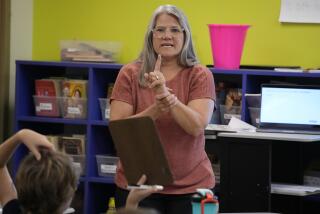Excitement in Numbers
- Share via
It is no exaggeration to say that mathematics education may hold the key to America’s continued world leadership in science and technology and all that springs from them. If students--even a few students--can be excited by mathematics at an early age, a great resource can be nurtured rather than turned off. For that reason and others, some distinguished mathematicians have become increasingly interested in recent years in how their subject is taught in the elementary and secondary schools. The question is how to excite young students.
William F. Lucas, a mathematician at the Claremont Graduate School, is a long-time scholar of game theory and operations research who now devotes much attention to the mathematics curriculum in the schools. In his view the mathematics taught through high school and into college is all very old, giving the impression that mathematics is a finished subject that has to be learned in order to solve problems. In fact, mathematics is a living subject in which new knowledge is being created every day. What’s more, Lucas says, much of this mathematics is at an elementary level, requiring few skills beyond counting and adding.
Last Saturday morning a dozen high-school math teachers attended a workshop with Lucas at Woodrow Wilson High School in East Los Angeles conducted under the auspices of the Los Angeles Urban Math/Science Collaborative. Lucas spent nearly four hours describing the growing importance of discrete mathematics--the mathematics of counting things--and detailing real-world problems in the field that are easy to state but can be devilishly difficult to solve. Earlier last week Henry O. Pollak, a past president of the Mathematics Assn. of America and formerly of Bell Laboratories, gave a talk to math teachers here in which he described how discrete mathematics had been put to use solving a very tricky problem for the telephone company: how to find the shortest network that links a large number of cities.
Lucas’ problems were of the same kind, all dealing with maps and graphs and trees and paths, problems in which the number of possible solutions quickly explodes beyond the ability of even the fastest computer to cope with them all. The math teachers responded with enthusiasm and split up into small groups to come up with ways to adopt Lucas’ problems as curriculum enhancements for their classes.
These are not idle problems. It turns out that discrete mathematics is the mathematics of computers. Just as calculus was developed three centuries ago as the handmaiden of theoretical physics, discrete mathematics is undergoing tremendous growth today as the handmaiden of computers. Mathematicians have found that very simple problems lead to very deep ideas. Many important theoretical questions remain unanswered and, at the present state of knowledge, unanswerable.
The effort to bring this to schoolchildren and to show them that theoretical mathematics is a living, breathing, developing science is a commendable undertaking that promises large rewards. At the least, it can make math interesting. At best, it can fire young imaginations to seek answers to unanswered questions.






